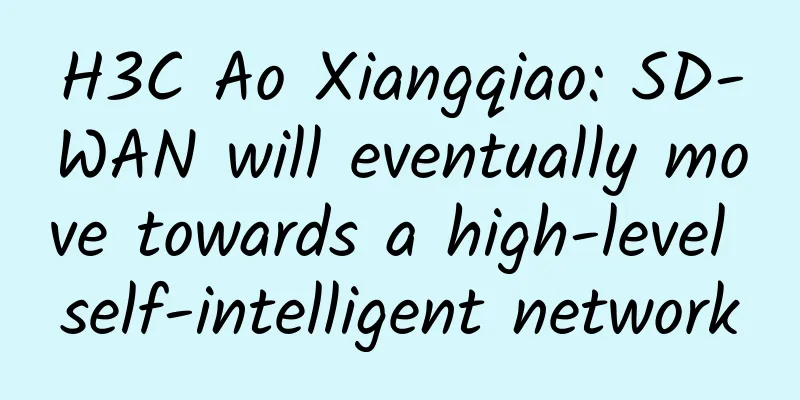Σco Time | Grasping new trends, Hunan's smart campus transformation is accelerating

|
【51CTO.com original article】 Networking, digitization, personalization, and lifelong learning have become important characteristics of educational development in the information age. As the country's requirements for educational informatization continue to increase, the education industry's demand for informatization and intelligence is becoming more and more urgent. Information technology and intelligent technology have begun to gradually integrate into the entire education process, promoting improved teaching, optimized management, and improved performance. Education informatization is accelerating from the 1.0 era to the 2.0 era. Recently, an online seminar with the theme of "Grasping new trends, accelerating the transformation of Hunan's smart campus" was held on the #Σco时间# live broadcast platform. Guests including Xie Chuanliang, Technical Director of Huawei's Hunan Government and Enterprise Business Education Industry, and Liu Chuanxian, Director of Sudi Technology's Products and Solutions, attended the meeting. Through keynote speeches, they fully demonstrated Huawei's strategic vision of using the "5G+AI" solution to lay the foundation for the digital transformation of universities, as well as Huawei's solutions for one-stop online services under the new trend. 5G+AI lays the foundation for the digital transformation of universities In April 2018, the Ministry of Education officially released the "Education Informatization 2.0 Action Plan", with the core goal of promoting education modernization through education informatization, comprehensively improving education quality, and building a new ecology for education in the new era. In this context, how to achieve digital transformation has become a common problem faced by the education industry. Xie Chuanliang, technical director of the education industry at Huawei Hunan Government Business, first pointed out the challenges and opportunities facing the digital transformation of colleges and universities in his speech: First, the business dedicated network is deployed independently, and the overall network construction cost is high. Due to the diversification of terminal services such as users and the Internet of Things, the network construction standards are inconsistent, and maintenance is difficult; second, the scale of development of multiple campuses makes network deployment difficult. The deployment and policy complexity brought about by the surge in applications and services has made network automation a common demand; third, traditional operation and maintenance methods are difficult to guarantee user experience. As wireless networks become increasingly popular, the inability to perceive user experience anytime and anywhere has become the biggest challenge for network operation and maintenance. From the actual scenario, on the one hand, as the main channel for campus business carrying WLAN, there are various experience problems from wifi4 to wifi5, such as slow fault repair, easy roaming interruption, no signal or weak signal, etc. On the other hand, the network's security defense capabilities are weak, and traditional firewalls are difficult to defend against new attacks. After the threat enters the intranet, there is a lack of effective detection and blocking measures. Threat handling mostly relies on passive manual defense. The defense capability needs to be upgraded urgently to form a security closed loop. To address these pain points, Huawei has proposed a digital transformation solution for education based on "5G+AI". The core lies in: building a WLAN fast lane based on 5G WiFi6; using AI to empower the entire network and lay the foundation for digital transformation. Specifically, the 5G-based smart antenna has a 20% longer coverage radius and more focused signals; the 5G-based smart application acceleration technology has an interactive teaching VR latency of less than 10ms, and AR/VR applications do not cause dizziness; the 5G-based software-defined radio frequency technology maximizes the value of the AP's entire life cycle; the 5G-based dynamic scheduling algorithm increases the throughput of high-density scenes such as conference rooms, auditoriums, and tiered classrooms by 40%. In addition, the integration of Wi-Fi and IoT solves the problems of hybrid network deployment and interference, and the integration of Wi-Fi and 5G base stations fully utilizes 5G transmission resources and saves networking costs. Xie Chuanliang also explained how to achieve AI support for the entire network. The three-level AI that makes the network more "smart" actually includes three layers of AI architecture, namely cloud AI, device AI and local AI. The three-level AI upgrades the automation level of the campus network. The future campus network is expected to achieve scenario-based optimal network self-recommendation, terminal access adaptation, typical fault self-closure, etc.; the three-level AI significantly improves the performance of the entire wireless network of the campus, especially the terminal rate; the three-level AI upgrades the active defense system of the campus network, realizes real-time perception of threat analysis, accurate identification of threat detection, and multi-platform linkage and collaboration for threat disposal, to prevent problems before they happen. In addition, by building a "convergent digital brain", traditional universities are promoted to achieve "multiple networks in one, one network for multiple uses" from independent private networks, and achieve on-demand definition, elastic expansion, and unified bearing. Since the construction of the fusion digital brain reduces the number of platforms and servers, it brings the advantages of reduced deployment costs and improved experience. Finally, Xie Chuanliang further explained the digital transformation plan for the education industry through the case of Xi'an Jiaotong University's construction of a "smart school town". Through in-depth demand research and in combination with the actual informatization construction of Xi'an Jiaotong University, Huawei has achieved one network for multiple uses, automated deployment, CampusInsight intelligent operation and maintenance, and elastic expansion of the Internet of Things in its design, which not only meets the current construction standards, but also lays a good foundation for the application of new technologies in the future. One-stop service solutions under the new trend Liu Chuanxian, Director of Products and Solutions at Sodi Technology, shared his thoughts online on the theme of "One-stop online services solutions under new trends". He first explained the connotation of "One-stop online services": data "connected", process "connected", business "connected", mobile "handling", intelligent "handling", and "handling" at any time. In public reports in the second half of 2019, the Hunan Provincial Department of Education was committed to extending "Internet + government services" and sprinting towards "One-stop online services". At this new starting point, the education industry has begun to show new integration in terms of data, management, teaching, portals, information, and terminals. In the informatization construction of colleges and universities, the introduction of the business middle-office architecture has also implemented the innovation of concepts. By encapsulating or reconstructing the back-end applications under the support of the technology platform to form shared services for business scenarios to support the rapid innovation of the front-end business, the middle-office service has gradually become a new trend. In order to manage service fragmentation, break through departmental barriers, integrate and derive cross-departmental processes, and realize "one-stop service", the data level should promote data governance and feed back process reengineering; the process level should promote business sorting and process optimization to achieve service reengineering; at the business level, a school-level business empowerment platform should be established horizontally to support service reengineering, and vertically, structural reengineering should be promoted through integration under the microservice architecture. In addition, in the handling of affairs, "handheld service" requires multi-terminal release, but unified standards and integration, so that users can get a consistent experience; "smart service" requires "easy to scan" and "easy to use", which can reflect importance, intelligence, pertinence, timeliness, interactivity, and personalization in actual operation; "anytime service" requires 7*24 duty and self-service. In terms of methodology, there are four main steps in the implementation: First, business sorting, which means investigating the existing application system and sorting out the business scope. At the same time, understand the service needs and classify the service objects; second, domain division, which means dividing the business domain according to the service population, service category and business scope; third, service fragmentation, sorting out the services required by each service object based on different school cycles (entering school, on campus, leaving school); fourth, role-based service sorting, which means analyzing the business and process based on sorting out the service needs, sorting out the services according to the role and service object, and reconstructing the process. Entering the implementation stage, the early stage should focus on the construction of the "process reengineering" management platform to consolidate the effectiveness of the one-stop service plan. In the mid-term, the reengineering should be supervised through the three lists of "responsibility list, approval list, and service list". In the later stage, the "digital brain" should be used to complete performance reengineering. Finally, the integrated delivery is completed to support user independent development. In the operation and maintenance stage, data empowerment and decision support should be achieved through multi-dimensional and scenario-based big data analysis. At the end of his speech, Liu Chuanxian combined typical cases such as the construction of the smart campus of Shanghai University of Technology and the information integration construction of Suzhou University's school affairs services to further deepen the online netizens' understanding of the connotation of "integration and innovation, ecological reconstruction" in the construction of one-stop services in universities. 【end】 The Education Informatization 2.0 Action Plan points out that educational informatization will serve as an endogenous variable for systematic reform of education, support and lead the development of educational modernization, promote the renewal of educational concepts, innovation of forms, and reconstruction of systems, and make my country's educational informatization development level in the forefront of the world. Educational informatization is facing both policy and historical development opportunities. Huawei is committed to becoming a global ICT partner for educational informatization, striving to bridge the "digital divide", improve teaching quality, and provide efficient, flexible, and secure solutions for the informatization and modernization of education. [51CTO original article, please indicate the original author and source as 51CTO.com when reprinting on partner sites] |
Recommend
[Black Friday] HostDare: $9.89/year-768MB/15G NVMe/1TB/Los Angeles Data Center
HostDare also released a Black Friday promotion p...
HostDare: Los Angeles VPS with 10% off monthly payment and 30% off annual payment starting at $18/year, annual payment gives double memory + double traffic
HostDare released the latest promotion in LET, of...
Several issues that must be understood about the NB-IoT protocol
The cellular-based Narrow Band Internet of Things...
5G will be everywhere
5G has been hyped as a new key technology for ent...
Hosteons 5th Anniversary Double Traffic for All VPS Hosts, VPS Hosts Annual Payment of $16, 5 Data Centers in Los Angeles/Dallas
Hosteons is currently running a 5th anniversary p...
Huawei FusionServer RH8100 adds another option to the mission-critical server market
With the transformation from "Made in China&...
5G bidding is finalized, and competition is changing again
[[417538]] 2021 is the third year of 5G commercia...
Huawei's Li Peng: Stimulate new growth and lead the first year of 5G-A commercialization
[ Barcelona , Spain , February 25, 2024 ] Today...
Huawei launches new smart security brand Huawei HoloSens, leading the smart security market
Dongguan, China, August 8, 2019 - At the "In...
How to apply code intelligence technology to daily development?
01/ Let’s start with the developers’ worries When...
HostYun: Unicom AS9929 line, minimum monthly payment starting from 18 yuan, maximum 500Mbps bandwidth, Los Angeles data center
AS9929 line is quite popular recently. China Unic...
RackNerd: KVM starts at $9.49 per year, Intel or AMD Ryzen, multiple data centers in Los Angeles/Seattle/San Jose, etc.
RackNerd is a foreign hosting company founded in ...
What are the layers of the TCP/IP network model?
Let me ask you, why do we need the TCP/IP network...
Microsoft: Open RAN is crucial to network cloudification and the two will eventually merge
In a comment document submitted to the US Federal...
Five-minute technical talk | A brief analysis of the stress testing method of the audio and video communication and signaling SIP protocol
Part 01 Audio and video communication process Aud...









